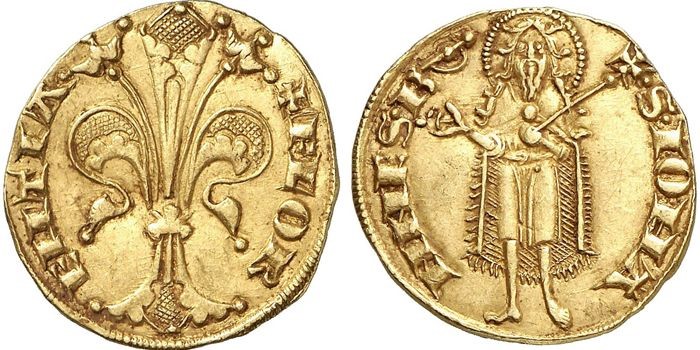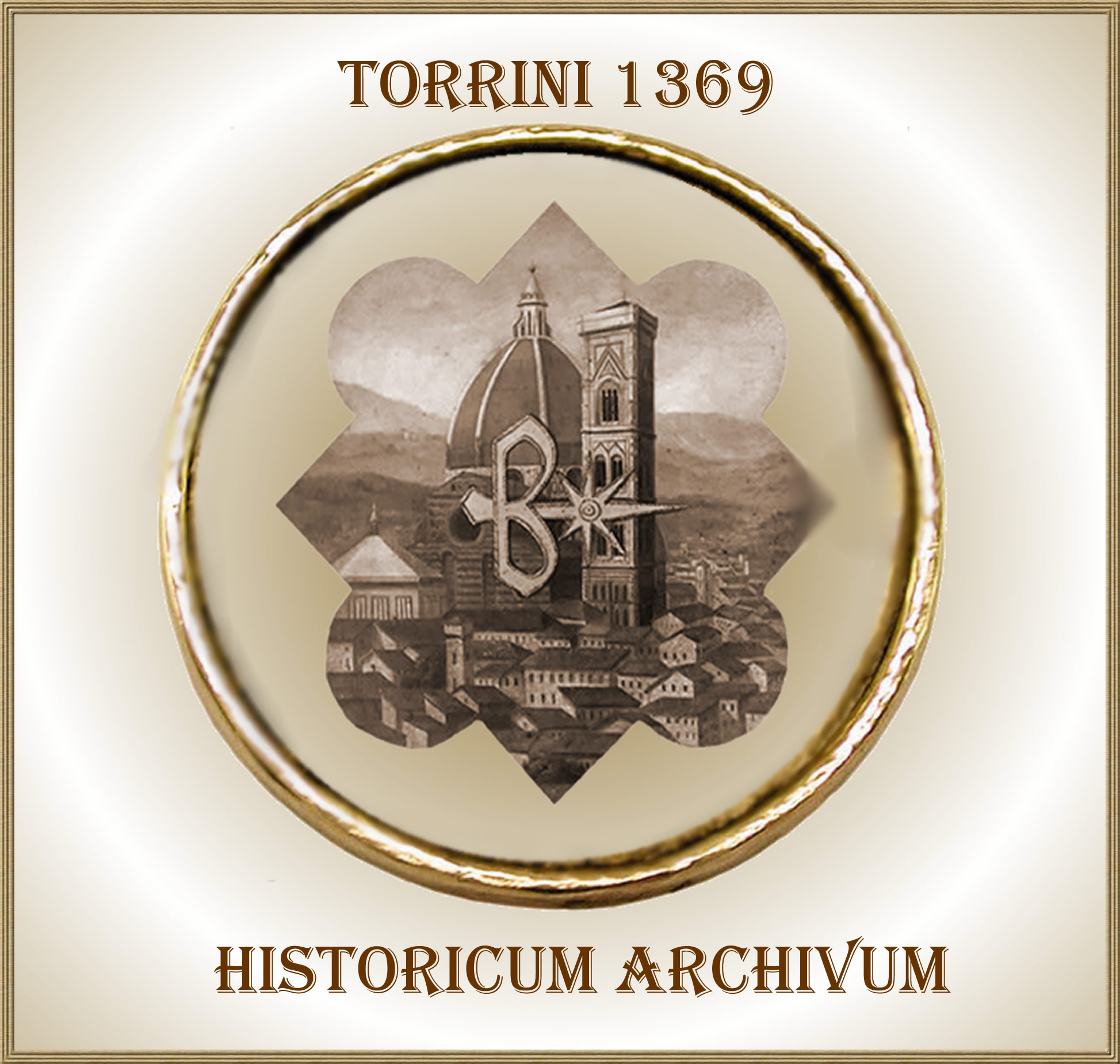- Home
- FLORENTINE STORIES
- The Florentine Mint
The Florentine Mint
there, where the Gold Florin took shape
(from Storie Fiorentine by Franco Torrini)
In the mid-thirteenth century, when Florence is in full growth, with Dante and Giotto in the city, it is possible to find the basis for the birth of the Republic of Florence with the government of the large corporations then in existence. The nobles are relegated to the background by the wealthy merchants of the people: merchants, bankers, small and great craftsmen belonging to the guilds of the various workers of the time or the called "Arts". Well-being spreads and the city becomes great, one hundred thousand inhabitants are estimated, a real record for the Middle Ages.
In this century the impulses of the guilds for the construction of the great monumental works such as the new cathedral of Santa Maria del Fiore, the large churches of Santa Croce and Santa Maria Novella, as well as the Bargello and Palazzo Vecchio, were born, which were subsequently completed in the following century.
This growing wealth of people, with an economy that expands even outside the walls, takes shape and the coining of a small pure gold coin is made to feed the exchange methods.

Thus was born in 1252, the Golden Fiorino weighing gr. 3,5 of pure gold which will become for more than three centuries one of the few gold coins to have an exchange rate on the medieval European market and beyond. On the front it bears the symbol of the city, the Iris and on the back the effigy of Saint John Baptist, patron of the City.
The minting of the Gold Florin takes advantage of the existing Mint which was born in 1237 as a service for wealthy citizens who wanted to convert their physical coin transactions into gold, in addition to the preponderant minting of the most popular silver coinage.
The Mint of State was located in the narrow houses existing near the “Torre della Vacca” which then was the base for the Arnolfo Tower of Palazzo Vecchio, on the banks of the then Scheraggio stream that passed right there and from which it came water was taken to make the powerful "hammers" work, which were used to beat money. He worked mainly with the Florentine "Mercatanzia" whose components, the merchants, brought metals, mainly silver, to transform them into current currency.
It is reported that in 1361 the Priors of the Republic of Florence authorized the purchase of a tower with adjoining cottage in the sixth of S. Piero a Scheraggio where the State Mint was established. During very recent archaeological excavations, portions of crucibles, refractory pipes and other signs of an era of great economic and work fertility have been found in the place.
The mint complex underwent many renovations over time and there is news that on the occasion of the start of the work of the new Loggia dei Lanzi by Vasari, in 1376, a part of the mint, dedicated to silver coinage, must have been moved near the river in the wall complex of the Torre della Notomia or San Francesco along the Arno and where this vestige is still located and took the name of Torre della Zecca.

The Tower of Notomia or San Francesco was part of a wall complex that defended the boundaries upstream of the crossing of the city by the Arno river and its navigation right in correspondence with one of the fisheries still existing today.
The Tower, together with the Tower of Justice, served as a military arsenal with deposits of ammunition, war material and foundries.
Placed on the banks of the Arno, it was hooked to a bend in the river from which the powerful hammers for minting the coins drew the energy of the water.
In the early 14th century, the New Mint returned to being a single body, right in front of the church of S. Piero a Scheraggio, behind the Loggia dei Lanzi, towards via della Baldracca, now via Lambertesca, in a complex of buildings of conspicuous dimensions with a monumental entrance and with a probable outlet on the Arno from which it obtained the liquid energy for the operation of the hammers necessary for the "beating" of the coins.
At that point it was a complex where the chests were located with the gold which was melted and refined with the primordial but very valid methods of the time, reduced to preordained discs, to then be "beaten" between the previously carved and engraved coins by famous engravers in order to obtain the desired coin. A real school from whose benches young engravers emerged, experts of the "cupellation" and of the fusion, managers of the multiple activities conducted there, as well as the merchants, who then brought around Europe the knowledge of instrumental and organizational techniques then almost unknown to the mints of other cities and nations.
An articulated "industrial" plant that minted up to 33,000 silver and mixture coins per day and about three hundred thousand Golden Florins per year and therefore always an average of one thousand Golden Florins per day for a total of 3.5 Kg ( at today's value around 147,000 Euros).
It had to be a swarm of workers, engravers, founders, guards who moved in controlled and controllable environments. In short, a large workshop that in the Middle Ages characterized Florence as one of the most renowned production centers in Europe.
It is believed that more than a hundred, perhaps two hundred, workers engaged in the activities of what was a real factory, with its master engravers, cashiers, a sort of trustee delegated to count and catalog the florins, the craftsmen with the task of creating the circular shapes of the coins, the founders involved in the casting of metals, the assayers with tasks of checking the title of the metals, up to the most humble "uvrieri". All part of a delicate situation from which theft or illegal trafficking could arise. It also came to require employees to pay a sum of money as a guarantee and against what were said to be disappearances at the time.
The task of checking that the coins were perfect was entrusted to the "Zecchieri or Zeccai Masters" appointed by the Art of Calimala for gold and by the Art of Exchange for silver, which were changed every six months for security reasons.
In this organizational, physical and intellectual context, the Gold Florin prospered and circulated for a long time. For almost three hundred years, between 1252 and 1533, when Alexander I de 'Medici, son of the great Cosimo, decreed the Grand Duchy of Tuscany and the coinage was changed.
The Gold Florin, imitated by all the most dynamic continental cities of the time, was subject to the events of the period with on the one hand representing the wealth of Florence and its "Merchants" and in contrast to this peculiarity of having to deal with illegal activities such as "shearing", that is, obtaining part of its gold content by "rasping" by removing gold content from the edges. The consequent decrease in weight brought the coin to its illegitimate situation which in popular jargon was called "bargellino". In fact devaluing its value.
In fact, for the aforementioned reasons, the Gold Florin which from the beginning was coined with a diameter of mm. 19 and of gr. 3.53, in 1422 while remaining of gr. 3,50 was coined with a diameter of mm. 21.
Thus began the era of the so-called "large florin" which put virtually all previous editions out of course even if it is said that they continued to circulate between large operators in pre-assembled and sealed bags called "Seal florins".
It was stably coined in quite pure gold (958.5) of gr. 3.53 except in 1402 of gr. 3.32 and in 1442 of gr. 3.55. This stability of the gold contained in the coin was the first and greatest reason for its success over time, making Florence become the main financial center of the European continent for over two centuries, even if it had no direct outlets on the sea.
It is said and written that a Gold Florin of that time could correspond to about 150/200 Euros today but at that time you could not go shopping with it! The cost of living was enormously lower and the silver florins were used which were worth one twentieth of the gold ones and the copper florins, also called "black florins" for their natural aptitude to oxidize, which were worth a 240th of Gold Florin.
A nefarious period for Florence because many banks had already declared bankruptcy after the terrible flood of 1333 which devastated the city, when also the Company of Peruzzi and the Company of Bardi, respectively in 1343 and 1346, failed with great fanfare because they had lent 1,300,000 Gold Florins to Edward III of England who never returned them, causing with this action an economic uproar of great proportions for all of Florence, aggravated by the profound famine already present and spread throughout Europe. Finally, on the eve of the penetration of the black plague occurred in 1348 which killed the population by 30% and more.
A period in which the Gold Florin had a numerical and algebraic contraction of great proportions which then only resumed after 1369. At that time, two years later, with one hundred thousand Gold Florins, the Medici family bought the Port of Livorno !
The Gold Florin survived the plague epidemic but, as we have seen before, not at the behest of Alessandro I de 'Medici who practically decreed its end with the advent of the Grand Duchy of Tuscany in 1533. The indelible memory of a gold coin that for over three hundred years has supported and implemented in its central part the Renaissance of Florence. From there was born the popular saying: a gold florin today to have a thousand tomorrow.

The mint tower today, in 2020



